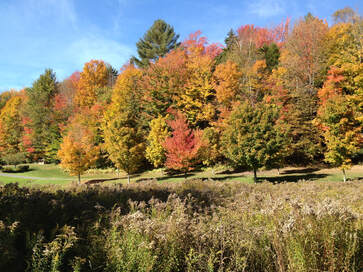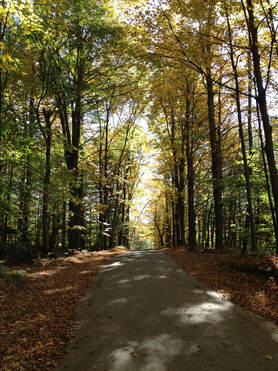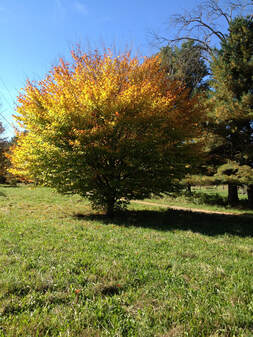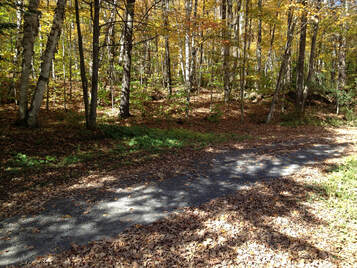Conservation Burial
A Primer on the Relationships with Conservation Organizations and Drafting of Conservation Easements

by Lee Webster
Only a handful of conservation burial grounds are operating in the US, each with unique operating models and practices. Their one defining characteristic is that each has partnered with a conservation land trust or government partner to create protective agreements and easements for the land and those buried there in perpetuity.
Land trusts have clear missions and strategies that enable them to accomplish varied goals within the scope of their properties and those lands where they hold easements. Deciding to make the financial and perpetual commitment to holding an easement on property owned by someone else is a weighty deliberate process. The conservation values present on the land must be compatible with the activities allowed on the property. Burial grounds are a relatively new ask from landowners and groups that are forming to purchase land for the purpose of natural burial. Because conservationists are risk averse, landowners who approach them with conservation burial, need to understand why and how to work with conservation organizations.
As more natural burial grounds become available to those seeking to benefit ecosystems and support conservation, appropriate language for instruments that protect those sustainable burial spaces has been difficult to find. The following information has been gathered to inform both potential burial ground landowners and the conservation community of some of the issues and concerns involved in conservation burial easements. It also includes practical language that has been approved in some existing burial grounds which may be valuable to both parties. Some general information is provided at the start for both groups, with the hope that it will begin the work of nurturing understanding and clear the way for concise, productive partner negotiations.
Only a handful of conservation burial grounds are operating in the US, each with unique operating models and practices. Their one defining characteristic is that each has partnered with a conservation land trust or government partner to create protective agreements and easements for the land and those buried there in perpetuity.
Land trusts have clear missions and strategies that enable them to accomplish varied goals within the scope of their properties and those lands where they hold easements. Deciding to make the financial and perpetual commitment to holding an easement on property owned by someone else is a weighty deliberate process. The conservation values present on the land must be compatible with the activities allowed on the property. Burial grounds are a relatively new ask from landowners and groups that are forming to purchase land for the purpose of natural burial. Because conservationists are risk averse, landowners who approach them with conservation burial, need to understand why and how to work with conservation organizations.
As more natural burial grounds become available to those seeking to benefit ecosystems and support conservation, appropriate language for instruments that protect those sustainable burial spaces has been difficult to find. The following information has been gathered to inform both potential burial ground landowners and the conservation community of some of the issues and concerns involved in conservation burial easements. It also includes practical language that has been approved in some existing burial grounds which may be valuable to both parties. Some general information is provided at the start for both groups, with the hope that it will begin the work of nurturing understanding and clear the way for concise, productive partner negotiations.

FREQUENTLY ASKED QUESTIONS
Why Should Land Trusts Consider Natural Burial on Their Properties?
The connections between conserved land and natural full body burial may not be obvious at first glance, but there are compelling reasons why both landowners and land trusts might consider it.
While we have been led to believe that cemeteries are inviolate, history shows that whole graveyard contents have been dug up and relocated, particularly from cities to the country, as urban sprawl and development encroaches on natural spaces. And this has happened despite the right of sepulcher, the American legal mandate that is supposed to afford the dead undisturbed repose for eternity.
Conserved land is a place that respects and protects animal lifecycles. The bodies of all beings that die on the land naturally decompose to enrich the soil and contribute to a balanced biosphere and ecosystem. Human burial at the most advantageous depth in most soil mediums, unimpeded by man-made, non-biodegradable container materials or attempts at preservation of the body, do the same. All scientific evidence points to the fact that current materials used in conventional cemetery management—concrete, steel, copper, exotic hardwoods, polyester fabrics, formaldehyde and other toxic chemicals, pesticides, herbicides, fertilizers—are the real dangers to soil and water. Adding natural human burial to the decomposition census is an environmental plus, not a burden.
Natural burial is consistent with the desire to reduce disturbance of soil. Very little space is disturbed as there is no need to accommodate vaults and oversized caskets. A pine casket made to fit takes up little room, and a simply shrouded body takes up less. Burials occur in the second horizon, between three and a half to four feet, with the soil returned in the reverse strata it was removed. Soil is then mounded—not removed—and the grave left to settle. Animal disturbances are not a concern, as the depth is sufficient to create a smell barrier that leaves animals unaware of what lies below, though they are often curious initially, pleased with the grubs and other easy pickings turned up. The grave is then left to naturalize. The area is carefully inventoried and restored with native plantings as a part of the botanical restoration plan and to offer families a living memorial in place of plastic flowers. A native fieldstone might be placed on the grave, but left to its own, not bolstered by underground concrete plinths.
Burials occur along planned access trails or in an open area or meadow designed specifically for the purpose, reducing the amount of foot traffic in the landscape. The burial ground itself is clearly defined through a system called plats, or planned grave spaces, in a select area, not scattered throughout the property. Responsible cemetery management along with conservation best practices results in a symbiosis similar to other activities allowed on conserved land.
A funeral event forges a bond between the deceased, family, friends, and the wider community. A funeral with a natural burial further connects those individuals in attendance to the land where it occurs. That connection will endure through generations of visiting family and community members, sparking a personal identification with wilderness spaces. Conservation burials are a unique opportunity not only to acknowledge the deceased and their contributions but to educate about the merits of natural ecosystems and our place in them.
That deeply personal—and even spiritual—connection to the land creates a relationship that land trusts have to work hard to build through other means. Their very survival depends on the robust giving of community members who see the value of conserving this particular farm, that particular watershed. Land where a person known to them is buried connects donors to the land in a way no other giving program can. Sustained protection of the land and acquisition of future worthy properties are made possible through what could become a family’s sustained intergenerational commitment to the land of their ancestors.
Direct costs of operating a viable burial ground are offset by opening and closing fees and plot sales, plus other potential revenue that is in keeping with the land trust’s mission. Income from event admission is growing as conservation burial grounds are becoming a place to educate, recreate, entertain, and gather for events, such as concerts, baptisms, weddings, and family picnics. Creative use of the space can provide a much-needed, enhanced revenue stream as a result of offering opportunities to experience the property in new ways. Visiting a cemetery for reasons other than funerals forms cognitive connections that go beyond sadness and sorrow. Shared experiences of joy and friendship that mark life’s milestones go even further to connecting participants to the land. This emotional investment is critical to fostering financial investment in the land trust’s mission to continue hosting meaningful events on the land and stewarding it for future generations.
Why Should Land Trusts Consider Natural Burial on Their Properties?
The connections between conserved land and natural full body burial may not be obvious at first glance, but there are compelling reasons why both landowners and land trusts might consider it.
While we have been led to believe that cemeteries are inviolate, history shows that whole graveyard contents have been dug up and relocated, particularly from cities to the country, as urban sprawl and development encroaches on natural spaces. And this has happened despite the right of sepulcher, the American legal mandate that is supposed to afford the dead undisturbed repose for eternity.
Conserved land is a place that respects and protects animal lifecycles. The bodies of all beings that die on the land naturally decompose to enrich the soil and contribute to a balanced biosphere and ecosystem. Human burial at the most advantageous depth in most soil mediums, unimpeded by man-made, non-biodegradable container materials or attempts at preservation of the body, do the same. All scientific evidence points to the fact that current materials used in conventional cemetery management—concrete, steel, copper, exotic hardwoods, polyester fabrics, formaldehyde and other toxic chemicals, pesticides, herbicides, fertilizers—are the real dangers to soil and water. Adding natural human burial to the decomposition census is an environmental plus, not a burden.
Natural burial is consistent with the desire to reduce disturbance of soil. Very little space is disturbed as there is no need to accommodate vaults and oversized caskets. A pine casket made to fit takes up little room, and a simply shrouded body takes up less. Burials occur in the second horizon, between three and a half to four feet, with the soil returned in the reverse strata it was removed. Soil is then mounded—not removed—and the grave left to settle. Animal disturbances are not a concern, as the depth is sufficient to create a smell barrier that leaves animals unaware of what lies below, though they are often curious initially, pleased with the grubs and other easy pickings turned up. The grave is then left to naturalize. The area is carefully inventoried and restored with native plantings as a part of the botanical restoration plan and to offer families a living memorial in place of plastic flowers. A native fieldstone might be placed on the grave, but left to its own, not bolstered by underground concrete plinths.
Burials occur along planned access trails or in an open area or meadow designed specifically for the purpose, reducing the amount of foot traffic in the landscape. The burial ground itself is clearly defined through a system called plats, or planned grave spaces, in a select area, not scattered throughout the property. Responsible cemetery management along with conservation best practices results in a symbiosis similar to other activities allowed on conserved land.
A funeral event forges a bond between the deceased, family, friends, and the wider community. A funeral with a natural burial further connects those individuals in attendance to the land where it occurs. That connection will endure through generations of visiting family and community members, sparking a personal identification with wilderness spaces. Conservation burials are a unique opportunity not only to acknowledge the deceased and their contributions but to educate about the merits of natural ecosystems and our place in them.
That deeply personal—and even spiritual—connection to the land creates a relationship that land trusts have to work hard to build through other means. Their very survival depends on the robust giving of community members who see the value of conserving this particular farm, that particular watershed. Land where a person known to them is buried connects donors to the land in a way no other giving program can. Sustained protection of the land and acquisition of future worthy properties are made possible through what could become a family’s sustained intergenerational commitment to the land of their ancestors.
Direct costs of operating a viable burial ground are offset by opening and closing fees and plot sales, plus other potential revenue that is in keeping with the land trust’s mission. Income from event admission is growing as conservation burial grounds are becoming a place to educate, recreate, entertain, and gather for events, such as concerts, baptisms, weddings, and family picnics. Creative use of the space can provide a much-needed, enhanced revenue stream as a result of offering opportunities to experience the property in new ways. Visiting a cemetery for reasons other than funerals forms cognitive connections that go beyond sadness and sorrow. Shared experiences of joy and friendship that mark life’s milestones go even further to connecting participants to the land. This emotional investment is critical to fostering financial investment in the land trust’s mission to continue hosting meaningful events on the land and stewarding it for future generations.

What Goes into Creating Landowner and Land Trust Partnerships?
Most often, lands that a land trust considers for easements are evaluated on the basis of conservation values that are present, such as historical features, rare or endangered plant or animal species, refuges for migrating birds, waterfront or watersheds, scenic vistas, or cultural features and values deemed a high preservation priority by that land trust. Proximity to other conserved land, waterways, recreational trails, agricultural lands, or greenways may also qualify the land for consideration.
For these reasons, and to locate hazardous or unsightly items, such as old tires, abandoned vehicles, dangerous cellar holes and wells, the landowner’s first step may be to conduct a thorough resource inventory and land survey. These costs are borne by the landowner, along with other incidental costs that may be incurred, such as specific botanical studies or refuse removal.
At the time of signing with a land trust, a one-time stewardship endowment is set aside to support the monitoring of the conservation easement. Some land trusts require a donation from the landowner to this endowment.
Once the easement is signed, the land trust is responsible for monitoring its boundaries, conservation values, and defending any encroachment or misuse that could occur. If legal action is necessary to enforce the terms of the easement, or prevent outside interference or pressure to develop, land trusts work with landowners to determine how to defend against these infractions. The land trust is also responsible for ensuring that conservation objectives are followed.
Current and future landowners are subject to the conditions of the easement. This means that the land will continue to be used in the way the signers envisioned, but it does not restrict a change of ownership, either within or outside the family. It also means that, as long as the activities have been stipulated in the easement, fee-based activities such as farming, forestry, or recreational trails may continue to operate.
Some land trusts own conservation land that has become a conservation cemetery. They can operate and manage burial grounds themselves or they can work with external organizations, subject to state and local laws, to support and manage the burial grounds, which keeps the land trust free to stay on mission.
Most often, lands that a land trust considers for easements are evaluated on the basis of conservation values that are present, such as historical features, rare or endangered plant or animal species, refuges for migrating birds, waterfront or watersheds, scenic vistas, or cultural features and values deemed a high preservation priority by that land trust. Proximity to other conserved land, waterways, recreational trails, agricultural lands, or greenways may also qualify the land for consideration.
For these reasons, and to locate hazardous or unsightly items, such as old tires, abandoned vehicles, dangerous cellar holes and wells, the landowner’s first step may be to conduct a thorough resource inventory and land survey. These costs are borne by the landowner, along with other incidental costs that may be incurred, such as specific botanical studies or refuse removal.
At the time of signing with a land trust, a one-time stewardship endowment is set aside to support the monitoring of the conservation easement. Some land trusts require a donation from the landowner to this endowment.
Once the easement is signed, the land trust is responsible for monitoring its boundaries, conservation values, and defending any encroachment or misuse that could occur. If legal action is necessary to enforce the terms of the easement, or prevent outside interference or pressure to develop, land trusts work with landowners to determine how to defend against these infractions. The land trust is also responsible for ensuring that conservation objectives are followed.
Current and future landowners are subject to the conditions of the easement. This means that the land will continue to be used in the way the signers envisioned, but it does not restrict a change of ownership, either within or outside the family. It also means that, as long as the activities have been stipulated in the easement, fee-based activities such as farming, forestry, or recreational trails may continue to operate.
Some land trusts own conservation land that has become a conservation cemetery. They can operate and manage burial grounds themselves or they can work with external organizations, subject to state and local laws, to support and manage the burial grounds, which keeps the land trust free to stay on mission.
What Are Conservation Easements?
Simply put, conservation easements are perpetual legal agreements between a landowner and a conservation organization that provide assurance to the landowners that a third party will provide oversight to ensure their conservation objectives for their property will be upheld and independently monitored by an organization whose environmental values are in alignment with their own. The landowner retains ownership and is responsible for the management of the property. The conservation organization becomes a deed signatory and holder of some of the property rights related to upholding the conservation objectives, agreed to by the landowner and the conservation organization.
Simply put, conservation easements are perpetual legal agreements between a landowner and a conservation organization that provide assurance to the landowners that a third party will provide oversight to ensure their conservation objectives for their property will be upheld and independently monitored by an organization whose environmental values are in alignment with their own. The landowner retains ownership and is responsible for the management of the property. The conservation organization becomes a deed signatory and holder of some of the property rights related to upholding the conservation objectives, agreed to by the landowner and the conservation organization.

Why Is an Easement the Right Tool for the Protection of Land with Burial Space?
Easements serve the living and generations to come, and provide the highest level of protection available. It is the secular instrument of a sacred covenant between humans and the land where the two meet in a very real way. Conservation easements have been proven to hold up to pressure for change in a way that even cemetery protections have not. Imminent domain has been unscrupulously used to remove graves to make way for parking lots and shopping malls, highways and high-rises. Cemeteries, despite being considered sacred ground by many, are operated by different entities allowed by the state that may not have the power, the funding, or the will once the cemetery is full and no longer revenue-producing, to withstand the challenge. Easements are built with teeth that exceed even the best cemetery safeguards.
People choosing natural burial do so with the understanding that their bodies will be undisturbed. For many, this is more than a property rights issue: it is their primary intent to have their bodies contribute to the natural ecosystem, to “be a tree” as the popular vision of green burial asserts. Knowing that an easement is held by a reputable, well-funded land trust that has pledged to defend them after death is reassuring to those seeking to turn their commitment to health of the planet into reality. An easement may be perceived as allowing people to exercise their most human impulse to denounce mortality by believing in a practice that will give them de facto control beyond the grave. The essence of natural burial to eschew the showy monuments and shrines and to blend into nature means that those buried need a champion when they become invisible.
Most importantly, conservation burial operators and stewards are equally committed to best conservation practices. For many, the need to conserve land comes first; the burials support conservation, restoration, and land acquisition. While their interest is in providing natural burial space and creating community around the practice, they are ever mindful of the imperative to contribute to the sustainability of its interdependent systems. Easements that include this low-impact, high-potential conservation strategy stand to protect the goals of both landowner and land trust alike through their ability to ensure the sustainable future of the land and its human residents. Burial and conservation are naturally compatible. Easements provide the power to make the burial sustainable and mutually beneficial.
Easements serve the living and generations to come, and provide the highest level of protection available. It is the secular instrument of a sacred covenant between humans and the land where the two meet in a very real way. Conservation easements have been proven to hold up to pressure for change in a way that even cemetery protections have not. Imminent domain has been unscrupulously used to remove graves to make way for parking lots and shopping malls, highways and high-rises. Cemeteries, despite being considered sacred ground by many, are operated by different entities allowed by the state that may not have the power, the funding, or the will once the cemetery is full and no longer revenue-producing, to withstand the challenge. Easements are built with teeth that exceed even the best cemetery safeguards.
People choosing natural burial do so with the understanding that their bodies will be undisturbed. For many, this is more than a property rights issue: it is their primary intent to have their bodies contribute to the natural ecosystem, to “be a tree” as the popular vision of green burial asserts. Knowing that an easement is held by a reputable, well-funded land trust that has pledged to defend them after death is reassuring to those seeking to turn their commitment to health of the planet into reality. An easement may be perceived as allowing people to exercise their most human impulse to denounce mortality by believing in a practice that will give them de facto control beyond the grave. The essence of natural burial to eschew the showy monuments and shrines and to blend into nature means that those buried need a champion when they become invisible.
Most importantly, conservation burial operators and stewards are equally committed to best conservation practices. For many, the need to conserve land comes first; the burials support conservation, restoration, and land acquisition. While their interest is in providing natural burial space and creating community around the practice, they are ever mindful of the imperative to contribute to the sustainability of its interdependent systems. Easements that include this low-impact, high-potential conservation strategy stand to protect the goals of both landowner and land trust alike through their ability to ensure the sustainable future of the land and its human residents. Burial and conservation are naturally compatible. Easements provide the power to make the burial sustainable and mutually beneficial.
View and download the complete document here
More content includes:
Burial Ground Operators: Learning the Language of Conservation
What Goes Into a Conservation Easement: Language suggestions
Another Instrument for Ensuring Protection: Agreements
What Documentation is Customarily Required
Resources
Burial Ground Operators: Learning the Language of Conservation
What Goes Into a Conservation Easement: Language suggestions
Another Instrument for Ensuring Protection: Agreements
What Documentation is Customarily Required
Resources
Your browser does not support viewing this document. Click here to download the document.
The death of the forest is the end of our life."
— Dorothy Stang

